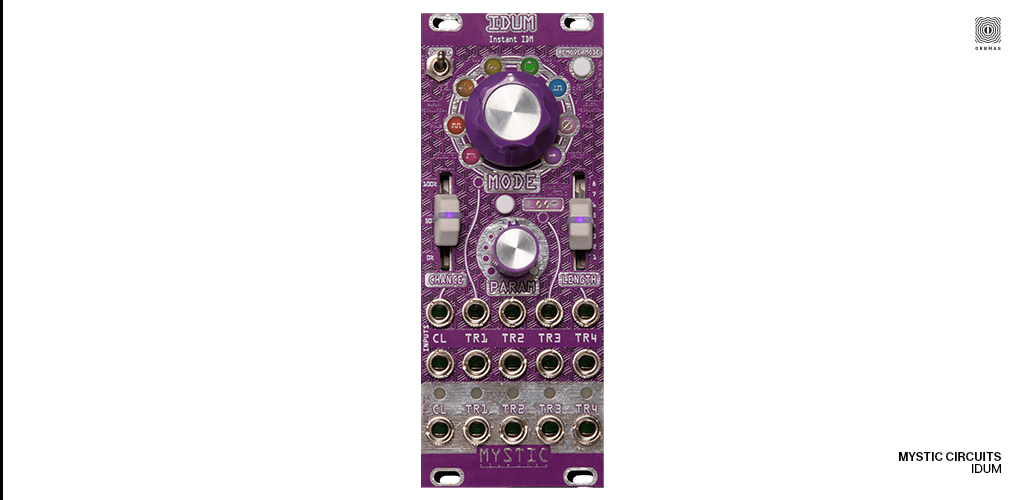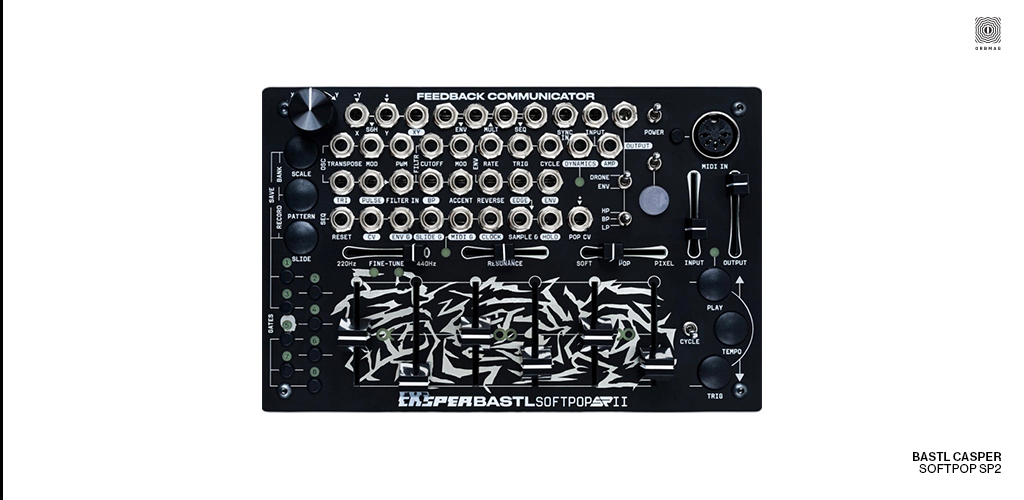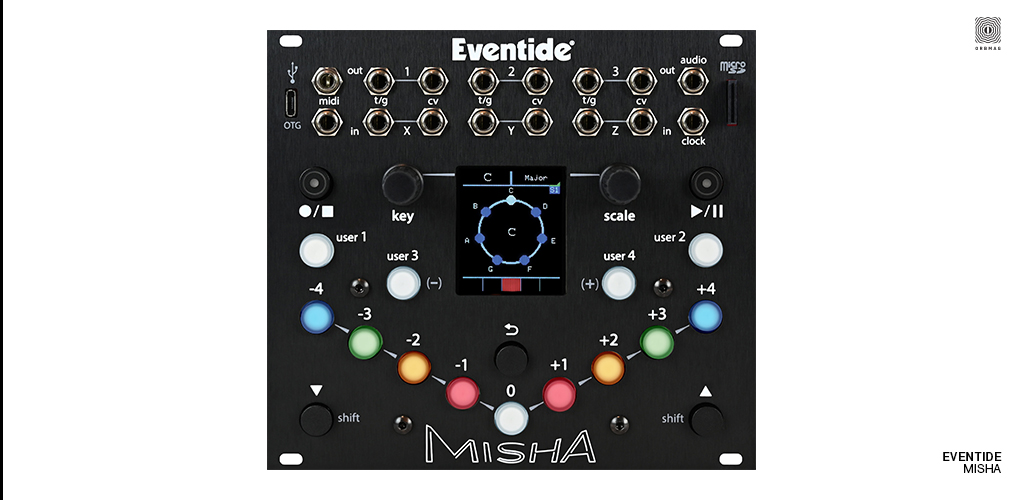Despite the persistent challenge of ongoing supply chain hurdles, 2022 was another busy year for eurorack hardware makers. As the choice among “building block” synthesis modules grows ever wider, designs and functionality have continued to evolve. While this list is by no means comprehensive—there were hundreds of modules released this year, many of them fantastic—we’ve put together a list of modular and semi-modular instruments that caught our eye.
Some of these, like IDUM and Softpop 2, represent incredibly unique and idiosyncratic approaches to making and manipulating sound. Others, like the Shaped Dual EnvVCA and QARV, combine multiple functions into single modules in extremely clever ways, allowing for more functionality to be packed into a smaller footprint—particularly handy for smaller, more purpose-driven systems. Whether you’re just starting out building your own eurorack rig or adding to an existing setup—or simply want to soak up some design inspiration from today’s electronic music hardware pioneers—here are a handful of 2022 releases that warrant a look.
Mystic Circuits IDUM

If you want to bring some wildness to your eurorack case, look no further than IDUM. Perhaps the most useful way to think about IDUM is as an effects processor for the sequences that run through it: patterns of triggers/gates get shuffled, warped, bounced and otherwise freaked by nine distinct operations, including everything from ratcheting and bouncing ball effects to skips, delays and bursts. The order, probability, and length of these operations can be controlled via CV, and the results are like having an extra ten pairs of hands keeping your rhythms from repeating—adding continuous interest and diversity to whatever simple (or not-simple) sequences you feed it.
And really, that’s just the tip of the conceptual iceberg: An eight-step looper is an entire world of possibility unto itself, looping incoming gates along with any effects that are applied to those gates. Additionally, IDUM can creatively drive external sequencers using its dynamic clock output; because of its relationship to the gates being input and output by the module, this clock output can do stuff like skip ahead or multiply the speed of the sequencer’s clock, or momentarily pause said clock for dramatic effect. (As a bit of insight into IDUM’s unconventional approach, it’s worth noting that this clock output essentially works by going insanely fast, letting it “lap” sequences and perform precise, advanced operations on them. As such, it works best with purely analog sequencers, including—but not limited to—Mystic Circuits’ own Tree and Leaves modules).
While IDUM can get things just about as chaotic as you can possibly imagine, a number of thoughtful touches allow it to be tamed to produce more conventionally musical results. You can reduce its overall effect by limiting which operations are applied to your sequence, as well as how often and for how long they occur. You can also determine the musical divisions at which these events can occur, making the results more “predictably musical” (it feels insane using the word “predictable” to describe IDUM, but oh well). In sum, IDUM is a wildly inventive addition to the world of eurorack, and a generous “happy accidents machine” that lets you apply various forms of mathematical wizardry to drums, melodies, modulation, or pretty much anything else happening in your patch.
Modbap Modular Trinity

With Trinity, it feels like Modbap has tackled its most ambitious and fitting eurorack module to date: a 20-hp drum synthesizer, with three powerful drum voices that can be shaped into nearly infinite variations of kick, snare, and hi-hat sounds. It’s a versatile digital drum synth, with an array of algorithms that make use of various synthesis techniques (additive, FM, Noise, analog-inspired) to produce a wide range of drum sounds, from razor-sharp kicks to bit-crushed snares and springy hi-hats.
Each drum voice is highly malleable, shaped by seven knobs and four mini-pots; this makes for a ton of fine control, especially for a drum machine with such a small footprint. Each of these drum channels has its own trigger and volt-per-octave input, as well as CV control over six other parameters, per channel. Combined with the ability to round-robin its different drum algorithms with the press of a button, Trinity makes it easy to avoid overly repetitive beats, through subtle or extreme modulation of each voice.
In the studio or onstage, Trinity is also a very flexible module, by virtue of its switchable output matrix. Each drum channel can be sent to the mix output, the individual drum channel output, or both simultaneously. This design makes for easy side-chaining, muting individual channels, and parallel processing your drums through distinct FX chains. Finally, a USB midi input lets you easily sequence Trinity from an external MIDI controller or computer.
And then there’s the sound. The expertly crafted algorithms are endlessly explorable, with enough range to achieve everything from pristine, full-bodied punch to crunchy, lo-fi dirt—and everything in between. You’ll definitely want to pair Trinity with a sequencer and a couple of modulation sources, but once you do, the sky’s the limit. If you’re looking for a powerful, compact drum synth for your eurorack case, you’d be hard-pressed to find a better bet than this.
Bastl Casper Softpop SP2

A follow-up to the original Softpop (which we reviewed in 2018), Softpop SP2 is a radical, semi-modular synth from one of the most consistently exciting collaborative teams in the world of music gear. The little desktop synth combines your choice of triangle-core analog or variable-waveshape digital oscillator core (selectable via a jumper inside), a pingable filter with cross-modulation, and profound digital control. As with the original Softpop, the concept revolves around the interplay between all of the device’s different elements—something surely influenced by Rob Hordijk’s seminal Benjolin, but here taken to exciting new places. The way its sample-and-hold circuit (among other things) is integrated into the signal chain makes sequences feel alive and constantly evolving in a way that few other synths do.
Unlike the original Softpop, the patch matrix now has 37 eurorack-compatible patch points, letting you easily patch the device internally, or to a larger eurorack setup. This time around, the device can also be sequenced and controlled via MIDI; in fact, the MIDI control is very deep and lets you control nearly every parameter of the synth. Arguably even more exciting is the built-in sequencer, which is packed with features, like the ability to sequence different scales, playback styles, and even effects. Each eight-step loop is a series of notes, gates and slides, and these can be played back and chained in any order. For such a small device, the depth and intuitiveness of the sequencer is remarkable.
Like the original, the SP2 also has a drone mode, as well as an audio input, effectively turning it into a wild effects processor for external audio sources. This audio is sent through the SP2’s powerful filter, VCA, and overdrive combo, adding new texture and grit. Adding in the SP2’s sequencer and envelope follower, among other things, allows for even more movement to the sound.
There are so many smart, clever touches to the SP2 it’s impossible to include them all here. The size and noise-free USB power make the SP2 extremely mobile. Essential key combos are printed directly on the enclosure, making it easy to get around when the manual isn’t nearby. The punch-in effects are great fun, as is the ability to cycle the envelope all the way up to audiorate. The comprehensive manual is full of intriguing ways to use the device, opening up new avenues to create melodies, noise, and pretty much anything in between.
Ziqal Dimension MK3

The third iteration of Ziqal’s remarkable digital oscillator squeezes an amazing amount of power into its mere 10hp footprint. An ultra-high-resolution, 32-bit wavetable engine seamlessly morphs between its 256 onboard wavetables, or any others loaded onto its SD card (it’s even compatible with Serum-format wavetables). Dimension is capable of playing four-note chords via either CV or MIDI mini-TRS inputs; in fact, each voice can be stacked up to six times, up to a massive 24-voice (!) limit. Four internal VCAs and ADSR envelopes provide four full voices of polyphony, and movement comes via the XY axes of its Dimension mode, which pans four voices across its stereo output.
And really, that’s just scratching the surface. You can alternatively run two separate wavetables simultaneously, with individual mono outputs in Dual mode, giving you two discrete oscillators in 10hp. One or both of its channels can also function as modulation sources, either for its own internal oscillator or to be sent to other modules, bringing an endless range of complex, scannable modulation shapes to your rig. The second output can even function as a handy MIDI-to-CV converter, outputting gates, trigs, or CV from whatever MIDI data is being fed into the module. These are just a few of the novel ways Dimension can be integrated into a larger patch, and all of this power is effectively managed and visualized intuitively via Dimension’s handy color display and sturdy push-encoder.
As if that wasn’t enough, there are also plans for the addition of voltage-controlled filters to the module’s bag of tricks in the very near future. Whether you’re looking to pack as much flexibility as possible into a small case, or to experiment with “in the box” computing power in the format of a tiny eurorack module, Dimension will open up new pathways for any eurorack rig.
4ms Shaped Dual EnvVCA

As the name implies, the Shaped Dual EnvVCA is fundamentally a two-channel analog envelope generator, with waveshapers and a built-in VCA. What makes the analog circuit design unique is that the waveform of each envelope can be manipulated—with a slider and/or CV—without actually changing the timing of the envelope. This allows for a broad range of new avenues to explore, such as bouncing ball effects with variable waveshapes, and modulating the shape of envelopes—both single-shot and looping—while still maintaining rhythmic continuity. The range time, controlled by two pairs of three-way switches, is also something to behold, going from 2.5kHz (.0004 seconds) on the low end to a full hour on the high end.
It’s also an extremely versatile module, functioning as a dual LFO or audio-rate oscillator, thanks to the envelopes’ flexible cycle modes—with a lot of room for shaping those waveforms. Each channel can also do double duty as a dedicated slew limiter, waveshaper, VCA (for audio or CV), sidechain processor, envelope follower, and plenty more. Each channel has both shaped and linear outputs and, crucially, attenuverters and offset controls for each of the shaped outputs; at 20hp it’s not small, but it’s an incredibly feature-packed module, and you’d chew up lots more space to achieve its functionality using multiple modules.
On that last point, it’s also worth noting that the Shaped Dual EnvVCA has two sister modules, which keep the general design in place but pare down feature set: The Dual EnvVCA is essentially the same module without the waveshaping at 16hp, and the EnvVCA chops that in half again to provide one channel of envelope plus VCA at 8hp. Whatever size option the space in your case affords, this is a premium envelope generator that’s sure to make its way into nearly every patch.
Tiptop Audio x Buchla Source of Uncertainty Model 266t

Along with several other of his ingenious designs, TipTop Audio brings Don Buchla’s classic Model 266t Source of Uncertainty to the eurorack format. Originally developed in 1976, the module has an interface and depth of functionality that feels elegant and timeless.
The 266t is a faithful recreation of the classic random voltage generator, featuring six distinct modulation tools packed into two sections of generation and modification. Onboard are three noise sources (pink, white, blue), three types of random voltages (fluctuating, quantized, and stored), as well as a sample-and-hold generator and an integrator (for proportionally smoothing out the incoming random voltages).
All of these form a unique and beautiful source of modulation signals that can easily stand up to anything that’s been developed in the 46 years since its inception. From its discrete circuits to its spacious layout and faceplate design, the 266t is a wonderful way to interact with the Buchla magic, exploring synthesis history in the form of a module that feels as modern and relevant as ever.
After Later Audio QARV

A bit of a swiss army knife of a module, QARV short quad attack, release, and VCA. In 20hp, it squeezes four channels of function generator, oscillator, slew limiter, envelope, and VCA, covering most of the utility function you’d be likely to need in a small or medium-sized rack. Each channel has a unipolar oscillator mode, along with knob and CV control over attack and release time, as well as shape control and an output attenuverter and VCA. What’s especially handy is that each channel normals to the channel that follows it, meaning QARV can be used as a four-channel mixer, with the final VCA output summing the channels before it.
There are differences between the channels: channel 1 has a 5V voltage source while channel 4 has 10V, for instance, and these channels can switch between slew mode and envelope mode. Channels 2 and 3, meanwhile, have bi-polar modes, making them function as individual oscillators. This flexibility brings to mind Make Noise’s classic Maths; while it takes a different approach, QARV can be used as a standalone synth voice, a quad envelope / LFO generator and mixer, or anything in between.
Tesseract Modular Step Fader mkII

Tesseract’s second crack at its Step Fader sequencer feels like it checks nearly all the boxes for a eurorack sequencer. Two rows of eight faders are used to control the pitch of each step, along with two rows of buttons to determine which steps get gates. The sequencer runs in three modes: dual (two independent eight-step sequencers with their own timing, length and directional modes), parallel (two 8-step sequencers that run in parallel and with shared control parameters), and single (one connected 16-step sequence). That’s useful but fairly standard stuff: where things get interesting are in the play modes, which include normal, reverse, pendulum, drunk and random to determine the direction the steps move in. Crucially, these modes can be CV-controlled, as can many other parameters like time division and transposition, making for an intuitive way of generating and shaping sequences, going far beyond simply eight steps running sequentially. The built-in quantizer massively boosts the functionality of the module, eliminating the need for an external module, and the buttons along the bottom do double-duty to set stuff like scales, slides, time divisions, and transpositions. A brilliant refactor of the classic step sequencer, packed with useful functionality.
Knobula Kickain

There are plenty of ways to make a kick drum in eurorack, but none quite like this one. In short, Kickain pairs a flexible kick drum voice with a built-in stereo sidechain compressor and reverb. Typically, you’d run either your bass voice or even the rest of your mix through this input, to get the sort of rhythmic pumping that only sidechaining can achieve. To achieve this in eurorack would normally require either a separate compressor module or an envelope follower combined with multiple VCAs and voltage processors—here, it’s essentially plug-and-play. Not only that, but in addition to a standard compressor, two spectral modes EQ the incoming audio to work nicely alongside the kick.
Oh, and about that drum sound: it’s a full-bodied 909-inspired virtual analog kick drum voice, complete with 1V/Oct pitch control, click, bend, and color options, along with punch, drive and envelope controls (which are conveniently shared with the compressor and reverb). On top of that, there’s a 24-bit stereo reverb for up to 10-second reverb tails, and the right channel can even function as a send/return path. There’s even a bass cut switch to remove frequencies below either 40Hz or 60Hz. If the kick drum often finds a place at the center of your compositions, Kickain will be right at home at the center of your rack.
Moog Mavis

The latest in Moog’s line of semi-modular eurorack synthesizers, Mavis comes as a DIY kit that snaps together in a matter of minutes. It can be powered standalone, or live happily inside a eurorack case, running on euro power. And more than anything, its impressively deep and clever patchbay makes it useful on a number of fronts.
Perhaps its most eye-catching feature is its analog diode wavefolder, which brings a host of new harmonic content (as opposed to traditional subtractive methods) and a west coast twist to the familiar Moog sound. There’s plenty more going on underneath the hood, and much of it is accessible via the patchbay, from a sample-and-hold circuit and mixer to an ADSR envelope generator and LFO that goes up into the audiorate range (and can be used as a second oscillator). One lovely addition is the use of crossfaders in its modulation routing, which lets you blend between its LFO and envelope generator to get interesting, asymmetric modulation shapes; these are conveniently normalled to its filter, pulse width and pitch. Interestingly, the sample-and-hold circuit is normalled to the oscillator rather than the typical noise circuit, which adds an interesting twist to the randomness it produces. For more conventional (or more esoteric) sample-and-hold functionality, both the s&h input and s&h gate can be repatched from other sources.
In many ways, the immediate appeal of Mavis is that it represents the classic, analog Moog sound, squeezed into perhaps the smallest footprint and lowest-profile to date. But it’s also full of interesting design touches, making it a deeper creative tool than it might first appear. It’s a great little package that makes an excellent starter synth for someone just getting their feet wet in modular synthesis, but also brings a surprising amount of utility and creative expansion to experienced patchers as well.
Eventide Misha

Recent years have seen a number of experimental approaches to composition, and Misha is one of the latest. With both eurorack and MIDI connectivity, it’s shallow enough to function standalone in a small skiff that can accommodate its 28 hp, or live alongside other modules inside a larger eurorack case. The heart of its concept is its unique approach: Rather than the notes of a traditional keyboard, the V-shape of buttons on the front panel represent different intervals. The “0” button replays the last note, and the two sets of four buttons play more or fewer intervals. Specific note values are determined by the currently selected key and scale, selected and essentially always visible on the screen—the list is exhaustive and includes microtonal scales.
Experimenting with intervals rather than the typical notes of a keyboard is an experience that feels decidedly new, full of happy accidents and curious discoveries. You can plug in a MIDI keyboard to play it—or, even cooler, a USB computer keyboard, which you can use to create custom mappings. There’s a chord mode, with up to three notes output via CV or MIDI. Sequencing follows suit: Rather than programming a series of notes, you start recording and then use the interval buttons to play in a sequence, which can then be looped, added to, and shifted around in limitless ways by changing scale, key, position and more. There’s even a built-in VCO, if you don’t want to fuss with connecting other sound sources. Whether you’re subsumed by music theory or completely resistant to it, Misha is definitely worth a look.
Hikari Instruments Dual LFO

Japanese eurorack manufacturer Hikari Instruments’ Dual LFO includes two independent, voltage-controllable LFOs, each with independent waveform outputs, reset, and CV inputs. For basics, you can control the frequency of each LFO with long sliders. What’s more interesting is how these dual signals are mixed together: two shorter sliders control the amplitude and offset for each LFO being sent to the A+B and A-B outputs. This allows for easy mixing together of both LFOs to create complex CV signals. It’s a subtle bit of interface and circuit design that makes it immediately clear what your LFOs are doing while squeezing a lot of interrelated animation outputs into a tidy footprint.
Boredbrain Monitr

Boredbrain has focused its creative output on handy utilities for intermingling different audio formats, and Monitr is no different. It’s a thoughtfully designed two-channel stereo output module that features balanced line level 1/4″ outputs, VU meters, and a dedicated 1/4″ TRS headphone output. You get two sets of stereo inputs; in addition to standard knob control of volume levels, volume can be controlled with voltage, turning each channel into a stereo VCA that responds to envelopes, LFOs, and the like. (With an envelope follower plugged in, you can even patch ducking or other dynamic effects.) Routing options let you send either channel or the master to the headphone output—either for use as a cue channel, or for external effects processing before going out to an external mixer, effectively giving you an effects send. Sound quality is pristine, and there’s a handy master mute for when you need it. A great output module for live performance.
Nano Caixa 104

One of the more aesthetically appealing eurorack cases out there, Nano’s 104hp aluminum Caixa brings with it a number of nifty additions. The case has seven built-in utilities: a balanced stereo input section (with LEDs and level control), two 1:3 buffered multiples, a precision adder, two LFOs, a sample-and-hold circuit, a four-channel (2X L+R) stereo mixer, and line and headphone outputs. This leaves plenty of space for fun stuff like oscillators and filters, and the built-in power supply and 18-slot busboard should provide plenty of juice to power them.









